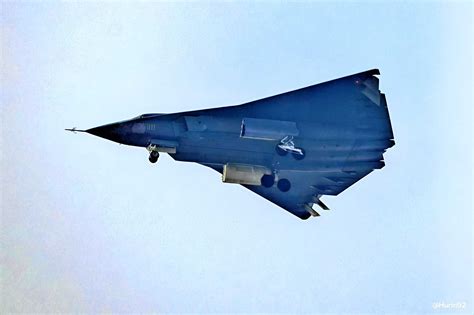
China’s potential next-generation stealth fighter, tentatively designated the J-36, has been captured in what analysts are calling the clearest images yet, fueling speculation about its capabilities and timeline for deployment. The detailed photographs, circulating on social media, offer an unprecedented look at the aircraft’s design, suggesting significant advancements in China’s aerospace technology and raising questions about its potential impact on regional and global power dynamics.
The images, appearing to show a prototype or demonstrator aircraft, reveal a twin-engine configuration with stealth shaping characteristics that closely resemble both the American F-35 and F-22 fighters. Notably, the aircraft features diverterless supersonic inlets (DSI), a design element intended to reduce radar signature and improve high-speed performance. Aviation experts believe that the J-36, if it enters service, could significantly enhance China’s air power projection capabilities and narrow the technological gap with the United States.
The appearance of these images coincides with ongoing tensions in the Indo-Pacific region, further amplifying the strategic significance of China’s military modernization efforts. While details about the J-36 remain scarce and largely based on visual analysis, the unveiling of such a sophisticated aircraft underscores China’s ambition to become a leading global aerospace power.
The leaked images of the J-36 prototype have ignited considerable debate among military analysts and aviation enthusiasts. According to Yahoo News, these images provide the “best view yet” of the advanced Chinese jet. This heightened visibility allows for more detailed comparative analysis with existing stealth fighters like the F-35 Lightning II and the F-22 Raptor, prompting discussions about its potential role in the People’s Liberation Army Air Force (PLAAF).
Design and Technology:
A prominent feature highlighted in the images is the J-36’s diverterless supersonic inlets (DSIs). These inlets are designed to manage the boundary layer airflow more efficiently than traditional designs, which use complex and heavy diverters. By removing these diverters, the aircraft reduces its radar cross-section, enhancing its stealth capabilities. DSIs also offer performance benefits, particularly at supersonic speeds, by optimizing airflow to the engines.
The overall design of the J-36 incorporates stealth features, including carefully shaped surfaces and internal weapons bays. These design elements aim to minimize radar reflections, making the aircraft more difficult to detect and track by enemy radar systems. The images suggest that the J-36 adopts a similar approach to stealth as the F-35, which uses a combination of shaping, radar-absorbent materials (RAM), and internal carriage of weapons to achieve a low radar signature.
The twin-engine configuration of the J-36 suggests a focus on performance and redundancy. Two engines provide greater thrust, enabling the aircraft to achieve high speeds and maneuverability. Engine redundancy is also a crucial factor for survivability in combat, as the aircraft can continue to operate even if one engine fails. This configuration is particularly important for long-range missions and operations in contested airspace.
Strategic Implications:
The development of the J-36 has significant strategic implications for the Indo-Pacific region and beyond. The introduction of a capable stealth fighter would enhance China’s ability to project air power, posing a challenge to existing U.S. and allied air forces. The aircraft could be deployed to defend China’s interests in the South China Sea, monitor regional flashpoints, and deter potential adversaries.
The J-36 could also serve as a symbol of China’s growing technological prowess and its determination to become a leading global military power. The development of advanced military hardware helps to bolster China’s prestige and influence on the international stage, reinforcing its role as a major player in global affairs.
The unveiling of the J-36 raises questions about the future balance of power in the Indo-Pacific region. The U.S. and its allies, including Japan and Australia, are closely monitoring China’s military modernization efforts. The deployment of the J-36 could prompt these countries to accelerate their own defense programs and strengthen their alliances in response to the perceived threat.
Comparison with Existing Stealth Fighters:
The J-36 is often compared to the American F-35 Lightning II, a single-engine stealth fighter designed for a variety of roles, including air defense, ground attack, and reconnaissance. The F-35 is currently in service with several countries, including the U.S., the U.K., Japan, and Australia.
While the J-36 and F-35 share some similarities in terms of stealth design, there are also notable differences. The J-36 is a twin-engine aircraft, whereas the F-35 has a single engine. This difference in configuration could have implications for performance, range, and payload. The F-35 is also designed to operate from a variety of platforms, including aircraft carriers, whereas it is unclear whether the J-36 is intended for carrier operations.
Another comparison is often made to the F-22 Raptor. While much older, the F-22 is an air superiority fighter known for its exceptional speed, maneuverability, and stealth capabilities. It’s considered by many to be the most capable air superiority fighter in the world. The J-36’s design cues certainly mimic aspects of the F-22, suggesting China’s ambition to reach a similar level of performance.
Uncertainties and Challenges:
Despite the excitement surrounding the appearance of the J-36 images, it is important to acknowledge the uncertainties and challenges associated with its development. The images only provide a snapshot of the aircraft’s design, and many key details, such as its engine performance, avionics, and weapons systems, remain unknown.
The development of a stealth fighter is a complex and expensive undertaking, requiring advanced engineering skills and significant financial resources. China has made substantial progress in its aerospace industry in recent years, but it still faces challenges in areas such as engine technology and advanced materials.
It is also unclear when the J-36 might enter service with the PLAAF. The aircraft is likely still in the prototype or demonstrator stage, and it could take several years of testing and development before it is ready for operational deployment.
China’s Military Modernization:
The development of the J-36 is part of a broader effort by China to modernize its military and expand its influence on the global stage. China has invested heavily in its armed forces in recent years, acquiring advanced weapons systems and expanding its presence in key regions.
China’s military modernization program has raised concerns among some countries, particularly the U.S. and its allies. These countries worry that China’s growing military power could be used to assert its territorial claims, challenge the existing international order, and undermine U.S. influence in the Indo-Pacific region.
China has consistently maintained that its military buildup is purely defensive in nature and that it poses no threat to other countries. However, its actions in the South China Sea and its assertive foreign policy have fueled skepticism among some observers.
Future Developments:
The J-36 is likely to undergo further testing and development in the coming years. It is possible that the aircraft’s design will evolve as engineers refine its performance and address any technical challenges. It is also likely that China will continue to invest in its aerospace industry, seeking to develop even more advanced military aircraft in the future.
The U.S. and its allies will continue to monitor China’s military modernization efforts closely. The deployment of the J-36 could prompt these countries to adjust their own defense strategies and strengthen their alliances in response to the perceived threat.
The future of the Indo-Pacific region is likely to be shaped by the ongoing competition between the U.S. and China. The development of advanced military hardware, such as the J-36, is just one aspect of this competition, which also encompasses economic, political, and diplomatic dimensions.
In-depth Analysis of Stealth Technology Integration:
Stealth technology, at its core, is about minimizing an aircraft’s detectability across various detection methods, primarily radar, infrared, visual, and acoustic. The J-36 appears to integrate a multi-faceted approach to achieve this.
-
Radar Cross-Section (RCS) Reduction: Shaping is paramount. The aircraft’s angles and curves are meticulously designed to deflect radar waves away from the source. The DSI inlets contribute significantly by eliminating the need for radar-reflective diverters. Furthermore, the internal weapons bays prevent radar waves from reflecting off exposed munitions. Radar-absorbent materials (RAM) are likely applied to the aircraft’s surface to absorb radar energy, further reducing its RCS. The specific type of RAM used is critical; advanced RAM can absorb a wider range of radar frequencies, making the aircraft stealthier against different radar systems.
-
Infrared Signature Reduction: Engine exhaust is a major source of infrared radiation. While the images don’t provide enough detail to assess specific exhaust cooling techniques, it’s likely that the J-36 incorporates measures to mix hot exhaust gases with ambient air, reducing the temperature differential and minimizing its infrared signature. Shaping the exhaust nozzles can also help to shield the hot exhaust from certain angles.
-
Visual and Acoustic Stealth: While less emphasized than radar and infrared stealth, visual and acoustic signature reduction are still relevant. Camouflage paint schemes can help to blend the aircraft with the background, making it more difficult to spot visually. Noise reduction technologies, such as optimized engine designs and sound-dampening materials, can help to minimize the aircraft’s acoustic signature.
The Role of Artificial Intelligence (AI) and Sensor Fusion:
Modern fighter aircraft rely heavily on advanced sensors and data processing to provide pilots with situational awareness and decision-making support. It is highly probable that the J-36 incorporates advanced sensor fusion and AI capabilities.
-
Sensor Fusion: Sensor fusion involves integrating data from multiple sensors, such as radar, infrared search and track (IRST), electronic warfare (EW) systems, and data links, to create a comprehensive picture of the battlespace. AI algorithms can be used to analyze and interpret this data, filtering out noise and identifying potential threats.
-
AI-Powered Decision Support: AI can also be used to provide pilots with decision support, helping them to prioritize targets, select the most effective weapons, and optimize flight paths. AI algorithms can learn from past experiences and adapt to changing battlefield conditions, improving the pilot’s overall effectiveness.
Potential Engine Technologies:
The engines powering the J-36 are critical to its overall performance. China has been working to develop advanced turbofan engines for its next-generation fighter aircraft.
-
WS-15 Engine: The WS-15 is a high-performance turbofan engine that is believed to be under development for the J-20 stealth fighter. It is possible that a variant of the WS-15 could also be used in the J-36. The WS-15 is expected to provide the J-20 with supercruise capability, allowing it to fly at supersonic speeds without using afterburners.
-
Advanced Thrust Vectoring: Thrust vectoring allows the aircraft to change the direction of its engine thrust, providing enhanced maneuverability. It is possible that the J-36 will incorporate thrust vectoring technology to improve its agility in air combat.
The J-36 and China’s Carrier Aviation Program:
While the initial images don’t definitively confirm carrier-borne capability, the J-36’s potential role in China’s expanding carrier aviation program cannot be ignored.
-
Foldable Wings: If the J-36 is intended for carrier operations, it would likely feature foldable wings to reduce its footprint on the flight deck and in the hangar.
-
Strengthened Landing Gear: Carrier-based aircraft require strengthened landing gear to withstand the high impact forces of arrested landings.
-
Catapult Launch Compatibility: China’s newer aircraft carriers are equipped with catapults, which allow them to launch heavier aircraft with greater payloads. If the J-36 is intended for these carriers, it would need to be compatible with catapult launch systems.
Countermeasures and Electronic Warfare Capabilities:
A modern stealth fighter must be able to operate effectively in a contested electromagnetic environment.
-
Electronic Warfare (EW) Systems: The J-36 likely incorporates advanced EW systems to jam enemy radar and communications, protect itself from missile attacks, and gather intelligence.
-
Directed Energy Weapons (DEW): While speculative, it is possible that the J-36 could be equipped with directed energy weapons, such as lasers, for self-defense or offensive purposes.
-
Towed Decoys: Towed decoys can be deployed to lure enemy missiles away from the aircraft.
The J-36’s Impact on Global Air Power Balance:
The introduction of the J-36 would have a significant impact on the global air power balance.
-
Challenging U.S. Air Superiority: The J-36 could potentially challenge U.S. air superiority in the Indo-Pacific region and beyond.
-
Accelerating the Arms Race: The development of the J-36 could prompt other countries to accelerate their own military modernization programs, leading to an arms race.
-
Shifting Geopolitical Dynamics: The J-36 could alter the geopolitical dynamics in the Indo-Pacific region, giving China greater leverage in its dealings with other countries.
FAQ
-
What is the J-36?
The J-36 is a tentative designation for a potential next-generation stealth fighter being developed in China. The newly emerged images are considered the clearest yet, revealing a twin-engine aircraft with stealth characteristics similar to the American F-35 and F-22 fighters.
-
What are the key features of the J-36’s design?
The J-36 features diverterless supersonic inlets (DSIs) to reduce radar signature and improve high-speed performance. The design incorporates stealth shaping and internal weapons bays. It also has a twin-engine configuration, suggesting a focus on performance and redundancy.
-
What are the strategic implications of the J-36’s development?
The development of the J-36 enhances China’s ability to project air power and poses a challenge to existing U.S. and allied air forces. It also serves as a symbol of China’s growing technological prowess and its ambition to become a leading global military power.
-
How does the J-36 compare to the F-35 and F-22?
The J-36 shares some similarities with the F-35 in terms of stealth design, but it is a twin-engine aircraft, whereas the F-35 has a single engine. The J-36 design cues mimic aspects of the F-22, suggesting China’s ambition to reach a similar level of performance, particularly in air superiority roles.
-
What are the uncertainties and challenges associated with the J-36’s development?
Many key details about the J-36, such as its engine performance, avionics, and weapons systems, remain unknown. The development of a stealth fighter is a complex and expensive undertaking, and it is unclear when the J-36 might enter service with the PLAAF. Furthermore, advanced technologies such as RAM development and engine performance remain challenges.









